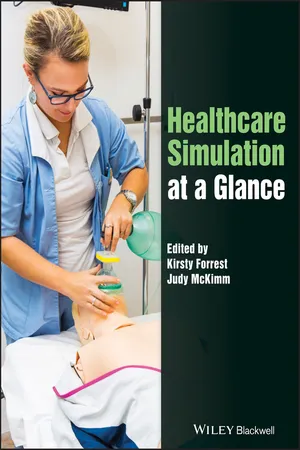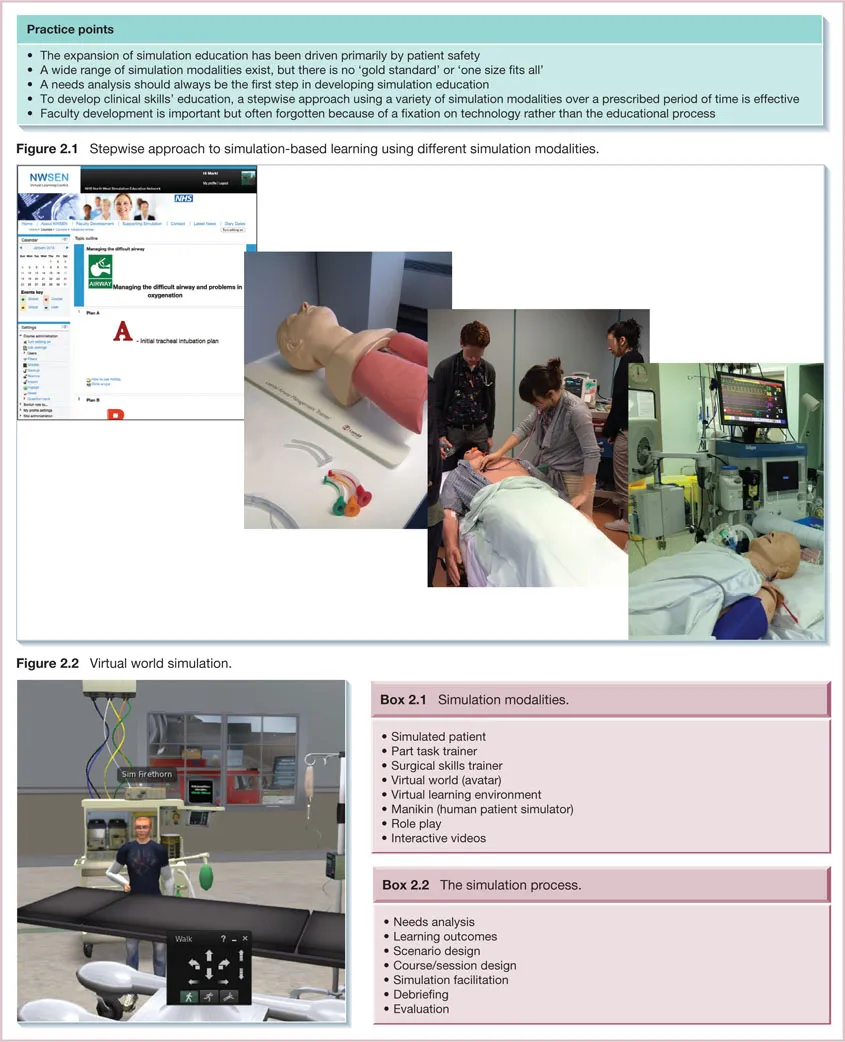
This is a test
- English
- ePUB (mobile friendly)
- Available on iOS & Android
eBook - ePub
Healthcare Simulation at a Glance
Book details
Book preview
Table of contents
Citations
About This Book
Healthcare Simulation at a Glance presents an accessible overview of everything you need to know about simulation in clinical practice and healthcare education.
From embedding simulation in programmes, to technical and non-technical features of simulation in a variety of contexts, to how simulation can be used in assessment and the provision of feedback to healthcare professionals, this practical guide is the perfect resource for developing the skills and knowledge required as both a student and an educator.
Healthcare Simulation at a Glance:
- Introduces the concepts and theories underpinning simulation practice
- Provides an understanding of the key terms and processes involved
- Includes a range of examples and tips for easy application in practice
Healthcare Simulation at a Glance is ideal for both those new to using simulation in education, as well as experienced academics.
Frequently asked questions
At the moment all of our mobile-responsive ePub books are available to download via the app. Most of our PDFs are also available to download and we're working on making the final remaining ones downloadable now. Learn more here.
Both plans give you full access to the library and all of Perlego’s features. The only differences are the price and subscription period: With the annual plan you’ll save around 30% compared to 12 months on the monthly plan.
We are an online textbook subscription service, where you can get access to an entire online library for less than the price of a single book per month. With over 1 million books across 1000+ topics, we’ve got you covered! Learn more here.
Look out for the read-aloud symbol on your next book to see if you can listen to it. The read-aloud tool reads text aloud for you, highlighting the text as it is being read. You can pause it, speed it up and slow it down. Learn more here.
Yes, you can access Healthcare Simulation at a Glance by Kirsty Forrest, Judy McKimm in PDF and/or ePUB format, as well as other popular books in Medicine & Medical Education. We have over one million books available in our catalogue for you to explore.
Information
Part 1
Overview and broad concepts
Chapters
- 1 Simulation
- 2 What is simulation education
- 3 Fidelity
- 4 Research in healthcare simulation
- 5 The evidence base for simulation education
1
Simulation

Simulations are used as a dress rehearsal to a real event where mistakes can be made and lessons learned, but no one comes to harm. Simulations include activities such as role play or team working tasks, use of manikins for life support training (Figures 1.1 and 1.2) and the use of computer-based simulators. Table 1.1 lists the range of simulated experiences in healthcare education. People from many occupations (including athletes, actors and pilots) routinely use simulation as part of their training. In these professions, in common with healthcare, people have to perform skills in what are often high pressure situations.
Historical context
The first recorded use of a medical simulator is that of a manikin created in the 17th century by a Dr Gregoire of Paris (Buck, 1991). He used a pelvis with skin stretched across it to simulate an abdomen, and with the help of a dead foetus explained assisted and complicated deliveries to midwives.
In spite of this early start, simulators did not gain widespread use in the following centuries, principally for reasons of cost, reluctance to adopt new teaching methods, and scepticism that what was learned from a simulator could be transferred to actual practice. All these reasons are still relevant today, but the combination of increased awareness of patient safety, improved technology and increased pressures on educators have promoted simulation as one option to address problems with traditional clinical skills teaching. Simulation has moved from the province of a few enthusiasts to a mainstream learning modality. As the American anaesthetist, David Gaba, comments:
No industry in which human lives depend on the skilled performance of responsible operators has waited for unequivocal proof of the benefit of simulation before embracing it. (Gaba, 1992)
Drivers and rationale
Most students and practitioners will be trained and assessed using some form of simulation and the use of clinical skills and simulation is now seen as routine in health professions’ education. Advances in technology have led to very life-like simulators for patients, surgery procedures and full-scale mock-ups of wards, theatres, delivery suites, ambulances and emergency departments. Many include software so that the simulator’s reactions depend on learners’ actions. There are many advantages to simulator training. The most obvious is that learners can practice as often as they like and whenever they want (within reason) without harming a patient.
Four key drivers for the widespread introduction of simulation are:
- Public expectation and patient safety. The public not only expect health professionals to engage in appropriate skills and simulator training, but they often believe that professions already do.
- Changes in working practice. The development of new professional roles, the growth of large and complex working environments, the move to more integrated service models and the rapid pace of modern healthcare require health (and other) professionals to develop effective leadership, team working and communication skills. Simulation has been at the forefront of the development (and assessment) of these skills.
- Technological developments and opportunities. The technology available to support simulator training has progressed rapidly in recent years. Evidence exists that the educational value of simulators depends on learner engagement rather than the cost of the equipment. See Figure 1.3 for how technology has gone hand in hand with simulator development.
- Service pressures and reduced training time. The impact of service pressures, shorter hospital stays, the shift of care into community-based services and (in the EU) the European Working Time Directive have resulted in a reduction in the time available for clinical training in the workplace. To make the best possible use of available time in the clinical setting, learners must have prepared effectively away from the workplace.
- Economic constraints and financial pressures. Maloney and Haines (2016) and Nestel et al. (2018) emphasise the importance of trying to evaluate the cost-effectiveness of simulation despite the difficulties of identifying long-term and high level impact on patient care and health outcomes.
Benefits for learners
The use of simulation in health professionals’ education has been shown to have benefits for learners, for the development of clinical practice and practical (technical) skills, and for patients and health systems (Riley et al., 2003). As well as facilitating the acquisition of routine skills, simulation also allows safe (for the learner and the patient) exposure to rare diseases/conditions, critical incidents, near misses and crisis situations. Reflecting the experience of the airline, nuclear and other high risk industries, evidence is accumulating that patient safety standards and non-technical skills (communication, leadership, etc.) improve following simulator training (McGaghie et al., 2010).
Østergaard and Rosenberg (2013) give the rationale, pedagogical and safety advantages of using simulation-based training as follows:
- It provides a safe environment:
- for learners without risk of harming the patient
- that is fully attentive to learners’ needs
- for training individuals and multiprofessional teams.
- It can be adjusted according to learners’ needs.
- It enables exposure to:
- gradually more complex clinical challenges
- rare emergency situations where time is an important factor.
- It provides an opportunity for:
- experiential learning
- repetitive training and deliberate practice
- individualised, tailored learning
- formative assessment, debriefing and feedback
- stimulating reflection
- learning how to learn
- summative assessment.
Future directions
Policy agendas from government and professional bodies have endorsed, promoted and funded patient simulation on a widespread scale. As well as helping to ensure patient safety and reduce error, simulation is also seen as an alternative means of learners acquiring clinical skills without spending time in an increasingly overcrowded clinical environment. Educators must therefore be attentive to such agendas and ensure that simulation is complementary to learning in the clinical workplace and that learning in each context is relevant to achieving defined outcomes and developing safe, competent practitioners.
Technological changes are now enabling more integrated multimedia simulations such as the use of handheld devices, portable simulators and further development of virtual reality simulators. With such technology, it is likely that simulation (in all its forms, including computer-based simulation) will become even more integrated into curricula and embedded into education and training programmes.
Opportunities for more interprofessional learning around non-technical skills and team working are also likely to increase as more centres offer such learning opportunities although more evidence is required as to the efficacy of such training. Simulation has also been used to support new ways of working (Forrest et al., 2013). As health and social services change toward more integrated, patient-led approaches, we may therefore see more use of simulation to support their introduction.
2
What is simulation education

Simulation-based education (SBE) is increasingly used to help learners and health professionals develop their knowledge, skills and behaviours, particularly around clinical skills and procedures (although SBE is wider than simply procedures). Simulation is often embedded in undergraduate and postgraduate curricula, used for the professional development of the health workforce and has been shown t...
Table of contents
- Cover
- Title Page
- Copyright
- Contributors
- Preface
- Acknowledgements
- Part 1 Overview and broad concepts
- Part 2 Simulation and education
- Part 3 Simulation in practice
- Part 4 Assessment, feedback and remediation
- Part 5 Developing your practice
- References
- Index
- End User License Agreement